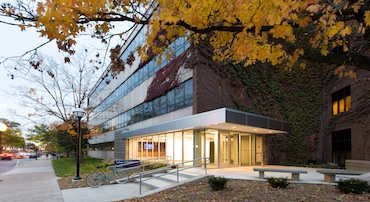Pharmacy Practice Experience Teaches P2s to Deliver Patient-Centered Care Through Interpreters

By: Toni Shears
Nearly 9% of people in the U.S. have limited English proficiency, and this can complicate healthcare interactions. That’s why medical interpreters are a necessary part of healthcare teams, but treating patients in tandem with an interpreter is a specialized skill that takes some practice.
The College of Pharmacy makes sure its students practice this skill. Through a required community outreach clinic, second-year PharmD students experience working side-by-side with an interpreter while providing primary care. A recent study shows that this experience boosts students’ confidence with this important skill.
In 2019, the College partnered with a low-income apartment community within Ann Arbor to provide health screenings for community members and hands-on primary practice experience for students. Many community members primarily speak Mandarin. All P2 students participated in the clinics, providing blood pressure and blood sugar checks for residents, most of whom are age 60 and older.
Over time, coordinators enhanced the screenings with translated educational materials and incorporated medical interpreters into clinic visits. That added a new layer of experience and opportunities for students to hone the essential skill of teaming with an interpreter — and improved primary care available to this community, according to Caitlin Ferguson, Assistant Director of Community Engagement and Adjunct Lecturer, who organizes the outreach clinics.
During health screenings, students practiced the softer skills of interacting with patients via an interpreter. For instance, they learned to resist the impulse to turn and speak to the interpreter, rather than the patient.
“I talk to P1 students in my patient communications class about the importance of making eye contact with the patient even if you're using an interpreter, but in a real interaction, it’s just a completely different feeling,” says Amy Thompson, PharmD, Director of Community Engagement and Clinical Professor of Pharmacy. “When you have this third party there, your natural tendency is to turn to that person because you're talking through them.”
“Future pharmacists must also avoid the tendency to use medical terminology as a result of their training. It’s always best to avoid medical jargon and scientific names when talking with patients, but it’s especially important when there’s a language barrier,” Thompson says.
In 2022–23, coordinators tracked the outcomes of students and patients participating in the clinic. After participating in screening sessions, P2s reported higher confidence in conducting blood pressure and blood sugar assessments. Importantly, they also felt more confident communicating via a medical interpreter, using written materials in other languages during patient interactions, and working on a team at the end of the event. “I think the comfort level working as part of a team is a really important aspect as well, because healthcare is teamwork,” says Sarah Vordenberg, PharmD, MPH, Clinical Associate Professor and Associate Chair of the Department of Clinical Pharmacy. She is the primary author on the study, which was published in Currents in Pharmacy Teaching and Learning in May 2024.
With near unanimity, students agreed that the experience with non-English speaking patients and interpreters should be kept as part of the Introductory Pharmacy Practice Experience (IPPE) requirements. Community members also reported positive experiences and a desire to continue to participate.
Language barriers and cultural differences can exacerbate health inequities. When patients struggle to understand prescribed instructions and how to incorporate treatment into their lifestyle, adherence to the treatment becomes a risk.
“It’s a tremendous benefit to give students an opportunity to practice delivering care with an interpreter,” Dr. Thompson says. “As someone who works with interpreters in practice, it's definitely something that, the more experience you have with it, the more successful you are. The fact that we can expose our students to this early on as part of our curriculum is huge for our students — and a benefit for their future patients.”
The program uses both professional medical interpreters and bilingual volunteer student interpreters, and they are contributing to the learning experience, said Vordenberg, “We’ve created a comfortable setting that empowers interpreters to give feedback to students. They might say, ‘Hold on a second. You’re speaking in whole paragraphs; let’s pause and focus on the patient.’ The interpreters are not only interpreting, but they're helping our students become more effective communicators..”
Another lesson students learn in the clinic is to translate their prescriptions and recommendations to fit the cultural context. “Students learn about population-level guidelines in the classroom. However, we do not want students to tell an 85-year-old woman who needs to reduce her carbohydrate intake that she needs to stop eating rice, when that is a staple of her diet and culture,” says Ferguson. Through practice with this population, students begin to see that clinical guidelines have a place and how they need to be individualized to align with a patient’s culture and health goals.
The effort to develop the clinic is paying off across campus and across professions. “The work Dr. Ferguson did to form relationships to ensure that the clinic is sustainable over time has informed the development of interprofessional activities where students from multiple disciplines can work together in community settings,” Dr. Vordenberg said. “Dr. Ferguson has been working with people from other units on campus to explore opportunities for this kind of practice. I think it serves as a model for not just pharmacy education, but also for students in medicine and dentistry, nursing, social work, and more.”
Based on the positive outcomes and student feedback, this program will continue to be a required part of the curriculum for second-year students. It provides a solid foundation for success when students go on to other clinical experiences, such as working in a University of Michigan Student-run Free Clinic in their fourth year.
“Interpreters are beneficial to patients We want to ensure that each of our students have the opportunity to develop their skills to effectively work with interpreters in a clinical setting,” Ferguson concludes.



